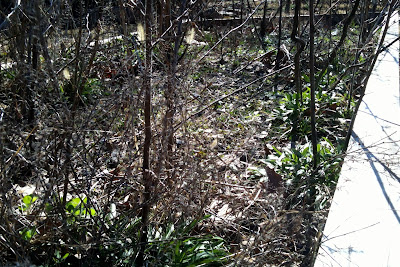The new home place already has two raised beds and for expediencies sake I will plant in them this year. Unfortunately, they are in the Bermuda grass lawn and are already infested with the stuff. Once a bed is infested with Bermuda grass, it's almost impossible to eradicate without the use of harsh chemical herbicides (which I refuse to use). The plan is to build new beds in a Bermuda grass free area of the property and transition to those as possible.
The beds had lain fallow for the previous year and were overrun with weeds. The upper bed was filled with a forest of 3-4' tall weeds. I pulled out all large weeds by hand and then cleaned up the surface with a hula hoe. The hula hoe is a simple blade that travels just under the soil surface and cuts off the weeds at the root. Because it doesn't dig deeply into the surface, it can be used during the growing season right up to the edge of crops.
The lower bed was especially overrun with Bermuda grass. I burned it off to dethatch it, then cleaned up the surface with the hula hoe. After a few days, I went back and used the hula hoe to remove anything that remained green.










This year we decided to do our own raised garden boxes we made ours out of old railroad ties lined with plastic, filled half way with topsoil, and the other half with a compost landscape mixture(purchased at a local home & garden store) potatoes look great and other plants just planted. Hopefully they will do great also please list ant tips that I maybe able to use thanks for all the information on your page
ReplyDeleteSounds like you've got a great start!
ReplyDeleteA couple of things come to mind:
Mulch. Mulch your beds. No seriously, mulch your beds. This is probably the single best thing you can do to increase yields. It keeps soil moisture from fluctuating dramatically, prevents roots being washed bare during watering, keeps the soil cool, and helps keep weeds down.
I've had great success with straw. Put down 4-6" down and pull it a few inches away from the base of each plant. You need the airflow around each plant base to help prevent fungal diseases. Do not use hay for mulch. Hay is full of weed seeds and that's the last thing you want to put onto your garden soil.
The other thing you can do is go ahead and order a bottle of NeemII now so that it's on hand when you have an insect problem. You WILL have an insect problem and early treatment can quell the problem before it gets out of hand. NeemII ( http://www.amazon.com/Green-Light-Neem-II-Spray/dp/B000GXQMQC ) is all organic and very, very effective as a spot treatment on a wide range on insects. They only thing that comes to mind that it wouldn't work well on is caterpillars. For them you'll want to hand pick them off and possibly use BT (also organic) ( http://www.amazon.com/Green-Light-27316-1-Pint-Organic/dp/B000UGPSMY/ref=sr_1_2?s=lawn-garden&ie=UTF8&qid=1332108483&sr=1-2 ).
Thanks for the info on insects. On the mulch topic the compost mixture has mulch mixed in with it. Is there such a thing as over mulching? Or any specific type you would recommend to use? My wife has done some research on raised beds and our own compost bins but all of them say different things to use and do not a single one said mulch. I do know we have had great success with mulch around our flowers. Thanks for all the tips. " remember new at this raised garden thing"
ReplyDeleteYou need a separate layer on top of the soil. Mixed in will not help. Certainly you can over mulch. A layer of straw 6" thick works very well. More than that and you may interfere with water penetration and you will start to have mulch up in the branches of some crops.
ReplyDelete